
Thursday, January 13
2:30 p.m. Theoretical Physics Seminar - Curia II
Speaker: H. Davoudiasl, University of Wisconsin
Title: Neutrino Masses from Sub-GeV Dynamics in Low-Cutoff-Scale Models
3:30 p.m. DIRECTOR'S COFFEE BREAK - 2nd Flr X-Over
4:00 p.m. Accelerator Physics and Technology Seminar - 1 West
Speaker: D. Seidman, Northwestern University
Title: Atom-Probe Tomography as a Tool for Solving Materials,
Science and Engineering Problems
Friday, January 14
2:00 p.m. Particle Astrophysics Seminar - Curia II
Speaker: R. Wechsler, University of Chicago
Title: Using Galaxy Clustering to Connect Mass and Light
3:30 p.m. DIRECTOR'S COFFEE BREAK - 2nd Flr X-Over
4:00 p.m. Joint Experimental Theoretical Physics Seminar - 1 West
Speaker: D. Dujmic, Stanford Linear Accelerator Center
Title: Sin2ß from Charmonium and Penguin Modes at BaBar
8:00 p.m. Fermilab International Film Society - Auditorium
Tickets: Adults $4
Title: Los Amantes del Circulo Polar (The Lovers of the Arctic Circle)
|

Thursday, January 13
Minnesota Wild Rice with Chicken
Tuna Melt on Nine Grain $4.75
Breaded Veal with Mushroom Cream Sauce $3.75
Sweet & Sour Pork over Rice $3.75
BLT Ranch Wrap $4.75
Cheesey Breadsticks $2.25
Chicken Pecan Salad $4.75
Wilson Hall Cafe Menu
Chez Leon will be closed through January and February
|




|
 |
"Quantum Diaries" Chronicles World Year
of Physics in Real Time, Real Lives
Members of the InterAction Collaboration for

|
DZero's Gordon Watts
is one of Fermilab's
bloggers. |
particle physics communication today (January 13)
launched "Quantum Diaries,"
a Web site that will follow the lives of some 25 physicists worldwide
as they live the World Year of Physics, 2005. In their own words, in
blogs, photographs and video clips, and in half a dozen languages,
the Quantum Diarists will give readers a real-time picture of the
lives of 21st-century scientists.
Writing in French, English, Russian, Japanese, Italian, Dutch and German,

|
Debbie Harris of NuMI
is another Fermilab
blogger. |
among other languages, scientists from universities and laboratories
in the Americas, Asia and Europe have volunteered to "blog" their
experiences, thoughts, impressions, triumphs and disappointments as
the year 2005 unfolds.
The 'Quantum Diaries' web site will be a marvelous contribution to the
global celebration of the World Year of Physics," said Dr. Raymond L.
Orbach, director of the U.S. Department of Energy's Office of Science.
"Albert Einstein after all was a person, and the public needs a sense
of how people do science. 'Quantum Diaries' promises to help the public

|
CDF's Tommaso Dorigo
is a Fermilab/INFN
blogger. |
understand how scientists think, behave, and accomplish their goals.
Diaries from real physicists, doing real physics, will show that
being a physicist is much more complex, frustrating and yet rewarding,
than most people think. Most of all, the fruits of scientific discovery,
and the intellectual contribution these discoveries make to our lives,
will become visible. We shall all be able to share in the delights
that drive these men and women to devote their lives to science.
"'Quantum Diaries' also will highlight other important facets of physics,"

|
Fermilab's fourth and
final blogger is
Jochen Weller, the
David Schramm Fellow
in the Theoretical
Astrophysics Group. |
Orbach said. "Science in general and physics in particular is international,
so it is fitting that diarists will contributing in many languages from many
nations around the world. DOE's Office of Science is the largest supporter
of basic research in the physical sciences in the United States, so it is
not surprising that all the American diarists are either employed by DOE's
national laboratories or users of their fantastic facilities and instruments."
read more
|


From BBC News, January 12, 2005
Sky surveys reveal cosmic ripples
By Jonathan Amos
In one sense, this work essentially explains why we are here.
The unimaginably big of today has its explanation in the fantastically small of 13 billion years ago.
Astronomers have shown how the present pattern of galaxies in the cosmos grew from tiny fluctuations in the density of matter just after the Big Bang.
The work draws on results from two scientific teams conducting sky surveys based in Australia and the US.
read more
|
From Seattle Times, January 11, 2005
Underground science lab gets tentative nod
WENATCHEE — The Port of Chelan County has released a draft resolution declaring its support of a proposed underground science laboratory near Leavenworth.
Final support hinges on whether scientists address community concerns about the lab.
Mark Urdahl, executive director of the port district, said the draft resolution amounts to a "conditional endorsement" of the
lab.
read more
|
From MSNBC, January 12, 2005
NASA launches comet-busting probe
Controllers look into potential problem with Deep Impact
CAPE CANAVERAL, Fla. - A NASA spacecraft with a Hollywood name — Deep Impact — blasted off Wednesday on a mission to smash a hole in a comet and give scientists a glimpse of the frozen primordial ingredients of the solar system.
With a launch window only one second long, Deep Impact rocketed away at the designated moment on a six-month, 268-million-mile (429 million-kilometer) journey to Comet Tempel 1. It will be a one-way trip that NASA hopes will reach a cataclysmic end on the Fourth of July.
read more
|
|
 |

More of the Same But Different:
Quarkonium Production at DZero
|

|
|
Normalized differential cross sections for the Upsilon(1S) as a
function of transverse momentum in three rapidity ranges compared to
QCD calculations from Berger et al. The absolute value of the cross-section in the rapidity range up to 1.8 has also been measured to be 695 +- 12 (stat) +- 75 (syst) +- 49(lumi) picobarns per unit of rapidity.
(Click on image for larger version.) |
|
Quarkonia are mesons in which the quark and the anti-quark are of the same type.
For example, the J/Psi consists of a charm and an anti-charm quark and the
Upsilon(1S) consists of a bottom and an anti-bottom quark. Quarkonium

|
Daniela Bauer
of
Indianna University
worked on this
analysis. |
production in proton-antiproton collisions provides an insight into the
nature of the strong force, one of the four fundamental forces and the
one responsible for holding together the quark constituents inside
the protons and neutrons that make up the nuclei of everyday matter.
The rate for direct production of quarkonium states at the Tevatron

|
Jundong Huang (left)
and
Andrzej Zieminski
of Indianna University
also
worked on this
analysis. Daniela Bauer
(above) gave Huang
a special custom made
hat after his Ph.D.
defense.
(Click on
image for larger
version.)
|
collider, reported by the CDF Collaboration and based on the Run I
data, turned out to be more than an order of magnitude larger than expected.
This observation generated a lot of interest and led to various theoretical
attempts to describe the data. The new measurement of the
Upsilon(1S) production by the DZero Collaboration extends studies of this
process to the higher center of mass energy and a much wider range of
rapidity, a variable related to the production angle with respect to
the beamline.
Upsilon(1S) states are detected by their decays into two muons.
Clean muon identification and efficient triggering over a large
angular range of the DZero detector has been essential for this
measurement, performed by a team of physicists from Indiana University.
The sample of approximately 45000 Upsilon(1S) candidates, collected
before the September 2003 Tevatron collider shutdown, was used to
determine the production rate. The figure shows good agreement in
a comparison between the data and recent theory predictions. The
DZero results were presented at the International Conference
on High Energy Physics in Beijing and will be submitted for
publication shortly.
|

|
|
These individuals
have been responsible for the operation of the muon system:
(From left) Leonid Vertogradov (JINR),
Huishun Mao (IHEP), Gennady Alexeev (JINR), Igor Vasiliev (IHEP),
Sergey Efremov (IHEP). Not shown: Rob Harrington (Northeastern U.) and
Yuriy Yatsunenko (JINR) (Click on image for
larger version.) |
|
Result of the Week Archive
|

Weekly Time Sheets Due Tomorrow
With the upcoming Martin Luther King Holiday, Weekly Time Sheets are due
in Payroll by 10:00 a.m on Friday, January 14, 2005
Watch Out for that Bump!
FESS is lowering the water level in the east Reflection
Pond in front of Wilson Hall in order to replace a
high voltage cable in the duct bank near the pond.
Please be mindful of the signs and slow down when driving
over the hose on Road A in front of Wilson Hall. This work
will continue through the end of next week.
If you have questions, please contact Joseph Pathiyil at x3363.
Fire Sprinkler System Updates on Martin Luther King Jr. Holiday
FESS will update the fire sprinkler system in Wilson Hall
on Martin Luther King Jr. Day on Monday, January 17. In order to accomplish
this task, the fire sprinklers will be disabled for the duration of the day.
Even though this is a holiday, and the lab will officially be closed, there
are some employees who will come to work. For those employees, FESS
requests that you sign in on a log sheet at the Guard's desk in the atrium of
Wilson Hall. When you leave, please sign out at the Guard's desk. The sprinkler
system will be re-enabled at the end of the day on January 17. ES&H and FESS
appreciate your cooperation.
New IRS Mileage Rate
Effective January 1, 2005, the standard IRS mileage rate for the business
use of your personal car (including vans, pickups or panel trucks)
was raised to 40.5 cents per mile up from 37.5 cents per mile in 2004. See
the Business Services Section,
On-line Services Web page
and click on Accounting Rates; then IRS Mileage
Reimbursement Rates.
The Business Services Section
Accounting Web page
now has a "Mileage
Reimbursement Report 2005" form for use in claiming applicable 2005 on and
off-site mileage reimbursements. This MS Excel form can be easily completed
and printed out from your computer.
Subscribe to Events Newsletter
To receive email notifications about upcoming cultural events at Fermilab,
please sign up for the online newsletter
FermiCulture.
Subscribers receive
approximately five emails per month with information on upcoming arts
performances, public lectures, films, etc.
Country Line Dancing Classes
Classes are held on Thursdays in the Village Kuhn Barn from
6:00 p.m. to 7:00 p.m.
This 6 week session is $30.00 and begins on January 20.
No Rec. Fac. Membership Needed. Register in the
Recreation Office. The deadline is January 14.
more information
Upcoming Activities
|
|








